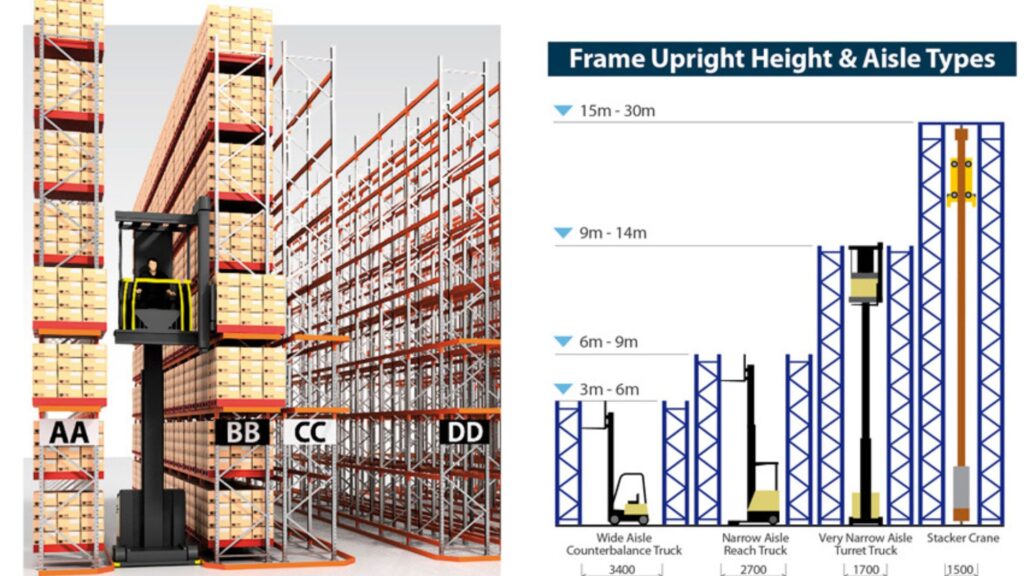The Pallet racking system is engineered to accommodate a wide array of warehouse storage requirements, it is a crucial component in warehouse storage solutions, offering versatility and efficiency to meet various storage demands. Aisle width is central to its adaptability, distinguishing between wide aisles vs narrow aisles. Wide aisles provide ample space making them ideal for environments that prioritize accessibility and flexibility. On the other hand, narrow aisles optimize space utilization, catering to warehouses with high-density storage needs and ensuring efficient navigation in confined areas. This flexibility in aisle configuration showcases the pallet racking system’s ability to adapt to the unique requirements of any warehouse setting seamlessly.
Choosing between wide and narrow aisle systems hinges on a careful analysis of inventory throughput, available floor space, and specific storage needs.
This blog will be your guide to enhancing your warehouse’s efficiency and productivity, understanding the unique advantages of each configuration and considering key factors, and introducing Metal Egypt as your partner while selecting the ideal solution for your warehouse storage requirements to optimizing your warehouse layout and maximizing storage efficiency.
Factors to Consider when Choosing Aisle Width
When choosing between wide aisles vs narrow aisles, several factors merit consideration to ensure functionality and safety. Firstly, assessing the frequency and volume of inventory movement helps determine the optimal aisle width to accommodate forklifts or other handling equipment efficiently. Additionally, evaluating the available floor space is essential; narrow aisles can maximize storage capacity in smaller areas, whereas wider aisles may be more suitable for larger warehouses. The desired storage density also plays a significant role; narrow aisles allow for higher-density storage by reducing aisle width, while wider aisles provide easier access but may sacrifice storage density. Consideration of the equipment used for material handling tasks is imperative; narrow aisles require specialized equipment, while wider aisles can accommodate standard forklifts or pallet jacks. Moreover, accessibility needs should be addressed; while wide aisles offer easier access for both personnel and equipment, narrow aisles may require more precise maneuvering but can maximize storage space. Safety regulations and standards must be adhered to, ensuring adequate aisle width for safe navigation of equipment and personnel. Additionally, flexibility and scalability are essential to accommodate future growth and changes in inventory or operational requirements.
By giving careful consideration to these factors, you can make an informed choice when selecting the width of the aisles for your pallet racking system, thereby maximizing efficiency and functionality in your warehouse operations.
Pros and cons of wide aisles selection
Wide aisles offer a range of advantages and disadvantages. each influencing the overall shopping experience and operational dynamics of the store. On the positive side, wide aisles contribute significantly to enhancing customer experience by mitigating crowding and fostering ease of navigation throughout the store. This layout not only accommodates individuals with disabilities but also creates a welcoming environment conducive to leisurely browsing and exploration. Moreover, the wide space afforded by wide aisles allows for better organization and presentation of products, facilitating enhanced visibility and accessibility for shoppers. This, in turn, has the potential to bolster sales through increased product engagement and improved aesthetics.
However, alongside these benefits, wide aisles come with certain limitations and challenges. Chief among these is the trade-off between space and product displays. While wide aisles promote a more open and inviting atmosphere, they inherently limit the number of product displays or shelves that can be accommodated within the store’s layout. Consequently, there may be a reduction in the variety and quantity of goods available to consumers, Moreover, the decreased stock density resulting from fewer displays may compromise the store’s ability to cater to diverse consumer preferences and shopping needs.
Furthermore, the expansion of aisle width may entail additional operational considerations and costs. The increased space necessitates larger floor areas, which, in turn, require more extensive flooring installations. Similarly, adequate lighting becomes paramount to maintain visibility and ambiance throughout the store, potentially leading to elevated energy expenses.
End point; retailers must carefully assess these factors and strike a balance that aligns with their overarching business objectives and customer-centric strategies.
Wide aisles’ different applications
Discussion about wide aisles vs narrow aisles would not be complete without addressing their practical applications. Wide aisles, compared to narrow aisles, play a pivotal role not only in retail settings but also across a diverse range of applications, each benefiting from the unique advantages and considerations associated with this spatial configuration. In retail environments, wide aisles serve as more than just pathways for customers to navigate through stores; they are integral components of the overall shopping experience. By offering ample space, wide aisles create an inviting and comfortable atmosphere, fostering a sense of openness and freedom for shoppers. Moreover, wide aisles facilitate better sightlines and visibility, enabling customers to explore product offerings more effortlessly and enhancing the overall browsing experience. Wide aisles, in contrast to narrow aisles, provide the necessary room for accommodating larger crowds and facilitating the smooth flow of foot traffic in high-traffic areas such as museums, galleries, airports, and exhibition halls. Additionally, in industrial and warehouse environments, wide aisles are essential for facilitating the movement of materials, equipment, and personnel. Within warehouses, wide aisles accommodate forklifts, pallet jacks, and other machinery used for material handling tasks, allowing for efficient loading, unloading, and storage operations. This also supports inventory management processes, enabling easy access to storage racks and shelving units for picking, packing, and replenishment activities. Moreover, wide aisles have applications in urban planning and design, influencing the layout of streets, sidewalks, and public spaces.
Advantages and disadvantages of narrow aisles
Narrow aisles in pallet racking systems have several advantages, including increased storage density, selective accessibility, improved stock rotation, and cost savings. However, they do require the use of specialized forklift equipment, which can lead to higher costs. The optimization of space provided by narrow aisles allows for more products to be stored in a limited area, making it ideal for warehouses with limited floor space and a need for flexibility and easy access to stock. On the other hand, wide aisles are more suitable for warehouses with ample floor space, as they provide easier access for personnel and equipment. Wide aisles can also accommodate standard forklifts or pallet jacks, which are more readily available and less expensive than the specialized forklifts needed for narrow aisles. Ultimately, the decision between narrow and wide aisles depends on the specific requirements of the warehouse, taking into account safety considerations, future growth, and flexibility.
Narrow aisles’ various settings
In each setting, whether discussing the advantages and challenges of wide aisles vs narrow aisles, a tailored approach is crucial to optimizing space utilization and addressing specific operational requirements. In retail environments, narrow aisles are strategically employed to optimize space utilization, allowing for the display of a greater number of products. However, this spatial arrangement can potentially disrupt customer flow and accessibility, leading to overcrowding and diminished comfort for shoppers. In warehouse settings, narrow aisles are integral components of high-density storage systems. They facilitate the efficient utilization of space and can significantly enhance storage capacity, particularly when paired with specialized equipment like narrow aisle forklifts. Nonetheless, navigating these confined spaces requires skilled operation to mitigate the risk of accidents and ensure the safety of workers. In residential spaces, narrow aisles or corridors may be inevitable due to structural constraints, but they can be enhanced through thoughtful design choices aimed at improving lighting and creating a sense of spaciousness.
Metal Egypt’s Versatile Pallet Racking Solutions
After getting to know about core differences between wide aisles vs narrow aisles, it is the perfect time to introduce Metal Egypt as a leading provider of versatile pallet racking solutions, catering to diverse warehouse storage needs with a comprehensive range of options that include both wide and narrow aisles. Metal Egypt’s pallet racking systems are engineered to offer unparalleled flexibility and efficiency, seamlessly adapting to the unique requirements of any storage environment. With wide aisles, Metal Egypt empowers businesses to prioritize accessibility and ease of navigation, ensuring ample space for maneuverability and enhancing customer experience. Conversely, narrow aisles optimize space utilization, allowing warehouses to maximize storage capacity and efficiency, particularly in high-density storage applications. By offering both wide and narrow aisle configurations, Metal Egypt provides customers with the flexibility to choose the solution that best aligns with their specific needs and operational preferences. With Metal Egypt’s pallet racking solutions, businesses can optimize their storage space while enhancing productivity and workflow efficiency, regardless of whether they opt for wide aisles or narrow aisles.

